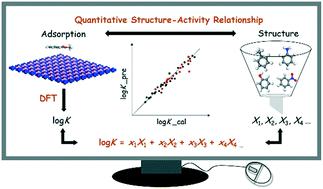当前位置:
X-MOL 学术
›
Environ. Sci.: Nano
›
论文详情
Our official English website, www.x-mol.net, welcomes your
feedback! (Note: you will need to create a separate account there.)
Predicting the adsorption of organic pollutants on boron nitride nanosheets via in silico techniques: DFT computations and QSAR modeling
Environmental Science: Nano ( IF 5.8 ) Pub Date : 2021-1-20 , DOI: 10.1039/d0en01145b Ya Wang 1, 2, 3, 4, 5 , Weihao Tang 5, 6, 7, 8, 9 , Yue Peng 1, 2, 3, 4, 5 , Zhongfang Chen 10, 11, 12, 13 , Jingwen Chen 5, 6, 7, 8, 9 , Zijun Xiao 5, 6, 7, 8, 9 , Xiaoguang Zhao 5, 14, 15 , Yakun Qu 5, 14, 15 , Junhua Li 1, 2, 3, 4, 5
Environmental Science: Nano ( IF 5.8 ) Pub Date : 2021-1-20 , DOI: 10.1039/d0en01145b Ya Wang 1, 2, 3, 4, 5 , Weihao Tang 5, 6, 7, 8, 9 , Yue Peng 1, 2, 3, 4, 5 , Zhongfang Chen 10, 11, 12, 13 , Jingwen Chen 5, 6, 7, 8, 9 , Zijun Xiao 5, 6, 7, 8, 9 , Xiaoguang Zhao 5, 14, 15 , Yakun Qu 5, 14, 15 , Junhua Li 1, 2, 3, 4, 5
Affiliation

|
Investigating the adsorption of organic pollutants onto boron nitride nanosheets is crucial for designing novel boron nitride adsorbents so as to remove pollutants from the environment. In this study, we performed density functional theory (DFT) computations to investigate the adsorption of 28 aromatic compounds onto boron nitride nanosheets, and developed four quantitative structure–activity relationship (QSAR) models for predicting the logarithm of the adsorption equilibrium constant (log K) values of organic pollutants adsorbed onto boron nitride nanosheets in both gaseous and aqueous environments. The DFT-predicted adsorption energies showed that boron nitride nanosheets exhibit stronger adsorption capability than graphene. Our QSAR analyses revealed that van der Waals interactions play dominant roles in gaseous adsorption, while van der Waals and hydrophobic interactions are the main driving forces in aqueous adsorption. This work demonstrates that in silico QSAR models can serve as efficient tools for high-throughput prediction of log K values for organic pollutants adsorbed onto boron nitride nanomaterials.
中文翻译:

通过计算机技术预测有机污染物在氮化硼纳米片上的吸附:DFT计算和QSAR建模
研究有机污染物在氮化硼纳米片上的吸附对于设计新型氮化硼吸附剂以从环境中去除污染物至关重要。在这项研究中,我们进行了密度泛函理论(DFT)计算,以研究28种芳族化合物在氮化硼纳米片上的吸附,并开发了四个定量构效关系(QSAR)模型来预测吸附平衡常数的对数(log K)在气态和水性环境中吸附到氮化硼纳米片上的有机污染物的值。DFT预测的吸附能表明,氮化硼纳米片比石墨烯具有更强的吸附能力。我们的QSAR分析表明,范德华相互作用在气体吸附中起主要作用,而范德华和疏水相互作用是水吸附的主要驱动力。这项工作表明,计算机硅QSAR模型可以用作高通量预测吸附在氮化硼纳米材料上的有机污染物的log K值的有效工具 。
更新日期:2021-02-25
中文翻译:

通过计算机技术预测有机污染物在氮化硼纳米片上的吸附:DFT计算和QSAR建模
研究有机污染物在氮化硼纳米片上的吸附对于设计新型氮化硼吸附剂以从环境中去除污染物至关重要。在这项研究中,我们进行了密度泛函理论(DFT)计算,以研究28种芳族化合物在氮化硼纳米片上的吸附,并开发了四个定量构效关系(QSAR)模型来预测吸附平衡常数的对数(log K)在气态和水性环境中吸附到氮化硼纳米片上的有机污染物的值。DFT预测的吸附能表明,氮化硼纳米片比石墨烯具有更强的吸附能力。我们的QSAR分析表明,范德华相互作用在气体吸附中起主要作用,而范德华和疏水相互作用是水吸附的主要驱动力。这项工作表明,计算机硅QSAR模型可以用作高通量预测吸附在氮化硼纳米材料上的有机污染物的log K值的有效工具 。











































 京公网安备 11010802027423号
京公网安备 11010802027423号